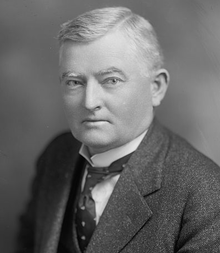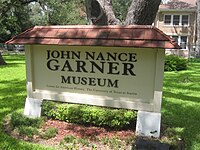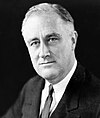John Nance Garner
John Nance Garner | |
|---|---|
 | |
| 32nd Vice President of the United States | |
| In office March 4, 1933 – January 20, 1941 | |
| President | Franklin D. Roosevelt |
| Preceded by | Charles Curtis |
| Succeeded by | Henry A. Wallace |
| 39th Speaker of the United States House of Representatives | |
| In office December 7, 1931 – March 3, 1933 | |
| President | Herbert Hoover |
| Preceded by | Nicholas Longworth |
| Succeeded by | Henry Rainey |
| House Minority Leader | |
| In office March 4, 1929 – March 3, 1931 | |
| Deputy | William Allan Oldfield |
| Preceded by | Finis Garrett |
| Succeeded by | Bertrand Snell |
| Leader of the House Democratic Caucus | |
| In office March 4, 1929 – March 3, 1933 | |
| Preceded by | Finis J. Garrett |
| Succeeded by | Henry Thomas Rainey |
| Member of the U.S. House of Representatives from Texas's 15th district | |
| In office March 4, 1903 – March 3, 1933 | |
| Preceded by | Position established |
| Succeeded by | Milton H. West |
| Member of the Texas House of Representatives from the 91st district | |
| In office January 10, 1899 – January 13, 1903 | |
| Preceded by | Sam Jones |
| Succeeded by | Ferdinand C. Weinert |
| Personal details | |
| Born | John Nance Garner III November 22, 1868 Red River County, Fifth Military District, U.S. |
| Died | November 7, 1967 (aged 98) Uvalde, Texas, U.S. |
| Resting place | Uvalde Cemetery Uvalde, Texas, U.S. |
| Political party | Democratic |
| Spouse(s) | |
| Children | 1 |
| Education | Vanderbilt University |
| Signature | |
John Nance Garner III (November 22, 1868 – November 7, 1967), known among his contemporaries as "Cactus Jack", was an American Democratic politician and lawyer from Texas. He was the 32nd vice president, serving from 1933 to 1941. He was also the 39th speaker of the United States House of Representatives from 1931 to 1933. Garner and Schuyler Colfax are the only politicians to serve as both the vice president of the United States and speaker of the United States House of Representatives.
Garner began his political career as the county judge of Uvalde County, Texas. He served in the Texas House of Representatives from 1898 to 1902 and won election to represent Texas in the United States House of Representatives in 1902. He represented Texas's 15th congressional district from 1903 to 1933. Garner served as House Minority Leader from 1929 to 1931, and was elevated to Speaker of the House when Democrats won control of the House following the 1930 elections.
Garner sought the Democratic presidential nomination in the 1932 presidential election, but he agreed to serve as Franklin D. Roosevelt's running mate at the 1932 Democratic National Convention. Roosevelt and Garner won the 1932 election and were re-elected in 1936. A conservative Southerner, Garner opposed the sit-down strikes of the labor unions and the New Deal's deficit spending. He broke with Roosevelt in early 1937 over the issue of enlarging the Supreme Court, and helped defeat it on the grounds that it centralized too much power in the president's hands. Garner again sought the presidency in the 1940 presidential election, but Roosevelt won the party's presidential nomination at the 1940 Democratic National Convention. Roosevelt then chose Henry A. Wallace as his running mate.
Biography[]
Early life and family[]
Garner was born on November 22, 1868, in a log cabin in Red River County, Texas to John Nance Garner II and his wife, Sarah Guest Garner.[1][2] The mud-chinked log cabin that Garner was born in no longer exists but the large, white, two-story house house he grew up in survives and is located at 260 South Main Street in Detroit, Texas. Garner attended Vanderbilt University in Nashville, Tennessee, for one semester before dropping out and returning home. He studied law at the firm of Sims and Wright in Clarksville, Texas, was admitted to the bar in 1890,[1] and began practice in Uvalde, Uvalde County, Texas.
In 1893, Garner entered politics, running for county judge of Uvalde County, the county's chief administrative officer. Garner was opposed in the primary by a woman—Mariette "Ettie" Rheiner, a rancher's daughter. Garner won, and with the Democratic nomination seen as tantamount to election in the post-Civil War Solid South, Garner was elected county judge and served until 1896.
Garner and Rheiner began dating after the primary. They married in Sabinal, Texas on November 25, 1895. They were the parents of a son, banker and businessman Tully Charles Garner (1896–1968). Mariette Garner served as her husband's secretary throughout his Congressional career, and Second Lady of the United States during her husband's tenure as vice president.
Texas politics[]


Garner was elected to the Texas House of Representatives in 1898, and re-elected in 1900. During his service, the legislature selected a state flower for Texas. Garner fervently supported the prickly pear cactus for the honor, and thus earned the nickname "Cactus Jack". (The Bluebonnet was chosen.)
In 1901 Garner voted for the poll tax, a measure passed by the Democratic-dominated legislature to make voter registration more difficult and reduce the number of black, minority, and poor white voters on the voting rolls.[3] This disfranchised most minority voters until the 1960s, and ended challenges to Democratic power; Texas became in effect a one-party state.[4]
Garner traveled parts of southern Texas controlled by the patrón system, currying political favor with the land bosses who exercised near-complete control of the local people and local elections. His patrón allies created a gerrymandered district for him, the 15th congressional district, a narrow strip reaching south to include tens of thousands of square miles of rural areas.[5]
Garner was first elected to the United States House of Representatives in 1902. He was elected from the district 14 subsequent times, serving until 1933. His wife was paid and worked as his private secretary during this period. Throughout his career he maintained allegiance to the white landowners who controlled the voting booths in South Texas. He regarded his Mexican voting base as "inferior and undesirable as U.S. citizens."[5]
Garner was chosen to serve as minority floor leader for the Democrats in 1929, and in 1931 as Speaker of the United States House of Representatives, when the Democrats became the majority.[6]
Garner supported passage of the federal income tax but opposed most tariffs except for those on wool and mohair, which were important to his Texas base. He also believed in rural investment, bringing taxpayer dollars to farmers of the Brush Country region of South Texas.[7]
Garner was popular with his fellow House members in both parties. He held what he called his "board of education" during the era of Prohibition, a gathering spot for lawmakers to drink alcohol, or as Garner called it, "strike a blow for liberty." (The "board of education" was continued by future Speaker Sam Rayburn after Prohibition had ended and Garner had left the House.)[7]
Vice presidency (1933–1941)[]

In 1932, Garner ran for the Democratic presidential nomination. It had become evident that Franklin D. Roosevelt, the Governor of New York, was the strongest of several candidates, but although he had a solid majority of convention delegates, he was 87.25 votes short of the two-thirds required for nomination. After Garner cut a deal with Roosevelt, thus allowing Roosevelt to win the nomination, Garner became his vice-presidential candidate.
Garner was re-elected to the 73rd Congress on November 8, 1932, and on the same day was elected Vice President of the United States. On February 8, 1933, then-Vice President Charles Curtis announced the election of his successor, House Speaker Garner, while Garner was seated next to him on the House dais. He was the second man, Schuyler Colfax being the first, to serve as both Speaker of the House and President of the Senate. Garner was re-elected Vice President with Roosevelt in 1936, serving in that office in total from March 4, 1933, to January 20, 1941.
Like most vice presidents in this era, Garner had little to do and little influence on the president's policies. He famously described the vice presidency as being "not worth a bucket of warm piss" (for many years, this quote was bowdlerized as "warm spit".)[8]
During Roosevelt's second term, Garner's previously warm relationship with the president quickly soured, as Garner disagreed sharply with him on a wide range of important issues. Garner supported federal intervention to break up the Flint sit-down strike, supported a balanced federal budget, opposed the Judiciary Reorganization Bill of 1937 to "pack" the Supreme Court with additional judges, and opposed executive interference with the internal business of the Congress.[9]
During 1938 and 1939, numerous Democratic party leaders urged Garner to run for president in 1940. Garner identified as the champion of the traditional Democratic Party establishment, which often clashed with supporters of Roosevelt's New Deal. The Gallup poll showed that Garner was the favorite among Democratic voters, based on the assumption that Roosevelt would defer to the longstanding two-term tradition and not run for a third term. Time characterized him on April 15, 1940:
Cactus Jack is 71, sound in wind & limb, a hickory conservative who does not represent the Old South of magnolias, hoopskirts, pillared verandas, but the New South: moneymaking, industrial, hardboiled, still expanding too rapidly to brood over social problems. He stands for oil derricks, sheriffs who use airplanes, prairie skyscrapers, mechanized farms, $100 Stetson hats. Conservative John Garner appeals to many a conservative voter.[10]
Some other Democrats did not find him appealing. In Congressional testimony, union leader John L. Lewis described him using tetrameter as "a labor-baiting, poker-playing, whiskey-drinking, evil old man".[11]
Garner declared his candidacy. Roosevelt refused to say whether he would run again. If he did, it was highly unlikely that Garner could win the nomination, but Garner stayed in the race anyway. He opposed some of Roosevelt's New Deal policies, most notably those related to wooing labor,[12] and on principle, opposed presidents serving third terms. However, Garner was also credited with steering a number of important bills through Congress in the crisis atmosphere of Roosevelt's first one hundred days in office and his relationship with the President would not become strained until Roosevelt's second term, when the Vice President's hopes of balancing the budget and paring New Deal programs faded.[13] He was also active in Roosevelt's Cabinet meetings on national policy and legislative strategy, which also resulted in the effective transformation of the previously ceremonial office of the U.S. Vice President.[13] However, the president's "court-packing" plan of 1937 widened the rift with Garner,[13] and the final blow in their relationship came when the president attempted to purge opposition Democratic members of Congress in the 1938 elections.[13]
At the Democratic National Convention, Roosevelt engineered a "spontaneous" call for his renomination, and won on the first ballot. Garner received only 61 votes out of 1,093. Roosevelt chose Henry A. Wallace to be his vice-presidential running mate.[14]
Final years and legacy[]

Garner left office on January 20, 1941, ending a 46-year career in public life. He retired to his home in Uvalde for the last 26 years of his life, where he managed his extensive real estate holdings, spent time with his great-grandchildren, and fished. Throughout his retirement, he was consulted by active Democratic politicians and was especially close to Roosevelt's successor, Harry S. Truman.
On the morning of Garner's 95th birthday, November 22, 1963, President John F. Kennedy called to wish him a happy birthday. This was just hours before Kennedy's assassination. Dan Rather states that he visited the Garner ranch that morning to film an interview with Garner, where Miss Texas Wool was in attendance, and that he then flew back to Dallas from Uvalde to deposit the film at then-CBS affiliate KRLD-TV (now Fox owned-and-operated KDFW-TV).[15]
Garner died on November 7, 1967, at the age of 98 years and 350 days. He is interred in Uvalde Cemetery. Garner is the longest-lived Vice President in U.S. history, a distinction which was previously held by Levi P. Morton (Benjamin Harrison's Vice President, who died in 1920 on his 96th birthday).
Garner and Schuyler Colfax, vice president under Ulysses S. Grant, are the only two Vice Presidents to have been Speaker of the House of Representatives prior to becoming Vice President. As the Vice President is also the President of the Senate, Garner and Colfax are the only people to have served as the presiding officer of both houses of Congress.
The popular Garner State Park, located 30 miles (48 km) north of Uvalde, bears his name, as does Garner Field just east of Uvalde. The women's dormitory at Southwest Texas Junior College in Uvalde bears his wife's name. John Garner Middle School, located in San Antonio's North East Independent School District, is also named after him.
John Nance Garner Museum in Uvalde, Texas, undergoing renovation in 2010/2011
Garner Museum restoration is being financed by the Briscoe Center of the University of Texas at Austin.
Footnotes[]
- ^ Jump up to: a b "John Nance Garner, 32nd Vice President (1933-1941)". Retrieved October 23, 2017.
- ^ Lionel V., Patenaude (June 15, 2010). "Garner, John Nance". tshaonline.org. Retrieved March 27, 2018.
- ^ "Nixon v. Condon. Disfranchisement of the Negro in Texas", The Yale Law Journal, Vol. 41, No. 8, June 1932, p. 1212, accessed 21 March 2008
- ^ Texas Politics: Historical Barriers to Voting, accessed 11 Apr 2008 Archived April 2, 2008, at the Wayback Machine
- ^ Jump up to: a b Minutaglio, Bill (2021). A Single Star and Bloody Knuckles: A History of Politics and Race in Texas. University of Texas Press. p. 68–69. ISBN 9781477310366.
- ^ "The Opening of the 72nd Congress | US House of Representatives: History, Art & Archives". history.house.gov.
- ^ Jump up to: a b Patrick Cox, University of Texas at Austin, "John Nance Garner," West Texas Historical Association joint meeting with the at Fort Worth, February 26, 2010
- ^ Johns, Daniel (July 1, 2012). "The Vice Presidents That History Forgot". Smithsonian. Retrieved January 3, 2017.
- ^ Sean J. Savage (1991). Roosevelt, the Party Leader, 1932–1945. University Press of Kentucky. p. 33. ISBN 978-0-8131-1755-3.
- ^ see online
- ^ Time August 7, 1939
- ^ "John Nance Garner". Texas Monthly. November 1996. Retrieved May 12, 2021.
- ^ Jump up to: a b c d "Garner the Vice President (1933–1941)". Briscoe Center for American History. Retrieved May 12, 2021.
- ^ Timothy Walch (1997). At the President's Side: The Vice Presidency in the Twentieth Century. University of Missouri Press. p. 50.
- ^ Dan Rather, The Camera Never Blinks (1976), page 113.
Further reading[]
- Anders, Evan. Boss Rule in South Texas. Austin, TX: University of Texas Press, 1982.
- Brown, Norman D. (2000). "Garnering Votes for "Cactus Jack ": John Nance Garner, Franklin D. Roosevelt, and the 1932 Democratic Nomination for President". The Southwestern Historical Quarterly. 104 (2): 149–188. JSTOR 30239246.
- Champagne, Anthony. "John Nance Garner", in Raymond W Smock and Susan W Hammond, eds. Masters of the House: Congressional Leadership Over Two Centuries (1998) pp 144–80
- "John Nance Garner, 32nd Vice President (1933-1941)". United States Senate. Retrieved September 15, 2018.
- Spencer, Thomas T. (January 2018). "For the Good of the Party: John Nance Garner, FDR, and New Deal Politics, 1933–1940". Southwestern Historical Quarterly. 121 (3): 254–282. doi:10.1353/swh.2018.0000. S2CID 149356041.
- Schwarz, Jordan A. (May 1964). "John Nance Garner and the Sales Tax Rebellion of 1932". The Journal of Southern History. 30 (2): 162–180. doi:10.2307/2205071. JSTOR 2205071.
- Timmons, Bascom N. Garner of Texas: A Personal History. 1948.
- Will, George. "In Cactus Jack's Footsteps". Jewish World Review Jan 6, 2000.
External links[]
| Wikiquote has quotations related to: John Nance Garner |
| Wikimedia Commons has media related to John Garner. |
- United States Congress. "John Nance Garner (id: G000074)". Biographical Directory of the United States Congress.
- Let's get goin'!, Bill Sykes Editorial Cartoon depicting Garner's 1940 presidential candidacy, December 19, 1939
- Conspicuous among the casualties, Bill Sykes Editorial Cartoon depicting Vandenberg and Garner in 1940 presidential primaries, April 4, 1940
- 1868 births
- 1967 deaths
- 20th-century vice presidents of the United States
- 1932 United States vice-presidential candidates
- 1936 United States vice-presidential candidates
- American Methodists
- Candidates in the 1932 United States presidential election
- Candidates in the 1940 United States presidential election
- County judges in Texas
- Democratic Party (United States) vice presidential nominees
- Democratic Party vice presidents of the United States
- Democratic Party members of the United States House of Representatives
- Members of the Texas House of Representatives
- Members of the United States House of Representatives from Texas
- Minority leaders of the United States House of Representatives
- Old Right (United States)
- People from Red River County, Texas
- People from Uvalde, Texas
- Speakers of the United States House of Representatives
- Texas Democrats
- Texas lawyers
- Vice presidents of the United States





